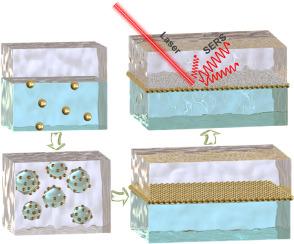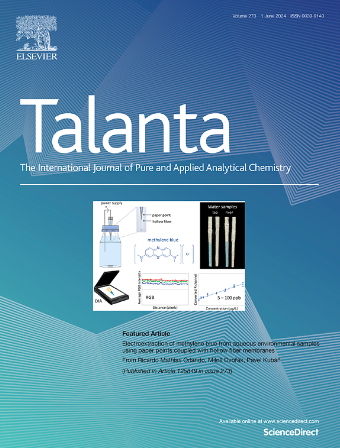Liquid metasurface for size-independent detection of microplastics
IF 5.6
1区 化学
Q1 CHEMISTRY, ANALYTICAL
引用次数: 0
Abstract
Microplastics (MPs) are widely distributed in water, soil, and air, drawing a global concern as a cause of chronic diseases and immune system disruption. Though as one of the most promising techniques in MP detection, the surface-enhanced Raman scattering (SERS) is heavily dependent on the distribution of the “hot spots” and the size of MPs, known as “coffee ring effect” and “size effect” respectively, imposing major challenges in the quantitative detection of various sized MPs on conventional SERS substrates. Here we present a self-healing metasurface based on plasmonic nanoparticle (NP) array at the liquid-liquid interface (LLI) and air-liquid interface (ALI). The fluidic nature of the metasurface and the repulsive forces between NPs offer atomic-level flatness and uniform distribution for “hot spots”. Additionally, MPs are dissolved in the oil phase, uniformly enriched in the form of polymer molecular chains on the liquid metasurface, irrespective of the size of the MPs. This molecular dispersity of the dissolved MPs enhances the overlap between the “hot spots” and scattering volume of MPs, significantly improving the intensity and reproducibility of SERS. The sensing platform is successfully applied in trace detections of various MPs (PS, PET, PMMA, and PC), and validated in real samples.

用于检测微塑料大小的液态元表面。
微塑料(MPs)广泛分布于水、土壤和空气中,是导致慢性疾病和免疫系统紊乱的原因之一,引起了全球关注。虽然表面增强拉曼散射(SERS)是最有前景的微塑料检测技术之一,但它在很大程度上依赖于 "热点 "的分布和微塑料的大小,即所谓的 "咖啡环效应 "和 "尺寸效应",这给在传统 SERS 基底上定量检测各种尺寸的微塑料带来了巨大挑战。在这里,我们提出了一种基于液-液界面(LLI)和气-液界面(ALI)上的质子纳米粒子(NP)阵列的自修复元表面。元表面的流动性和 NP 之间的排斥力为 "热点 "提供了原子级的平整度和均匀分布。此外,MPs 溶解在油相中,以聚合物分子链的形式均匀地富集在液体元表面上,与 MPs 的大小无关。溶解的 MPs 的分子分散性增强了 MPs 的 "热点 "和散射体积之间的重叠,从而显著提高了 SERS 的强度和可重复性。该传感平台已成功应用于各种 MPs(聚苯乙烯、聚对苯二甲酸乙二酯、聚甲基丙烯酸甲酯和聚碳酸酯)的痕量检测,并在实际样品中得到了验证。
本文章由计算机程序翻译,如有差异,请以英文原文为准。
求助全文
约1分钟内获得全文
求助全文
来源期刊

Talanta
化学-分析化学
CiteScore
12.30
自引率
4.90%
发文量
861
审稿时长
29 days
期刊介绍:
Talanta provides a forum for the publication of original research papers, short communications, and critical reviews in all branches of pure and applied analytical chemistry. Papers are evaluated based on established guidelines, including the fundamental nature of the study, scientific novelty, substantial improvement or advantage over existing technology or methods, and demonstrated analytical applicability. Original research papers on fundamental studies, and on novel sensor and instrumentation developments, are encouraged. Novel or improved applications in areas such as clinical and biological chemistry, environmental analysis, geochemistry, materials science and engineering, and analytical platforms for omics development are welcome.
Analytical performance of methods should be determined, including interference and matrix effects, and methods should be validated by comparison with a standard method, or analysis of a certified reference material. Simple spiking recoveries may not be sufficient. The developed method should especially comprise information on selectivity, sensitivity, detection limits, accuracy, and reliability. However, applying official validation or robustness studies to a routine method or technique does not necessarily constitute novelty. Proper statistical treatment of the data should be provided. Relevant literature should be cited, including related publications by the authors, and authors should discuss how their proposed methodology compares with previously reported methods.
 求助内容:
求助内容: 应助结果提醒方式:
应助结果提醒方式:


